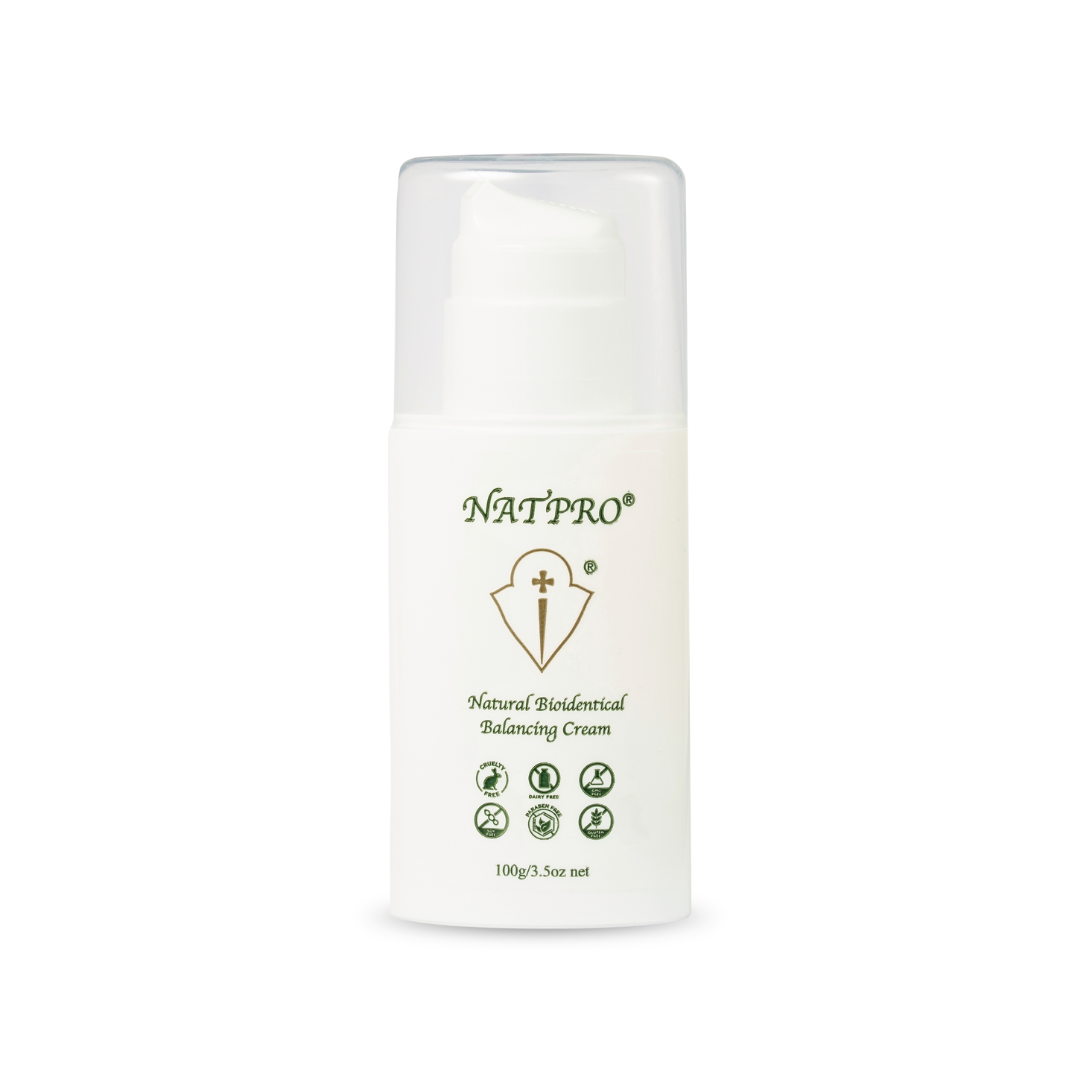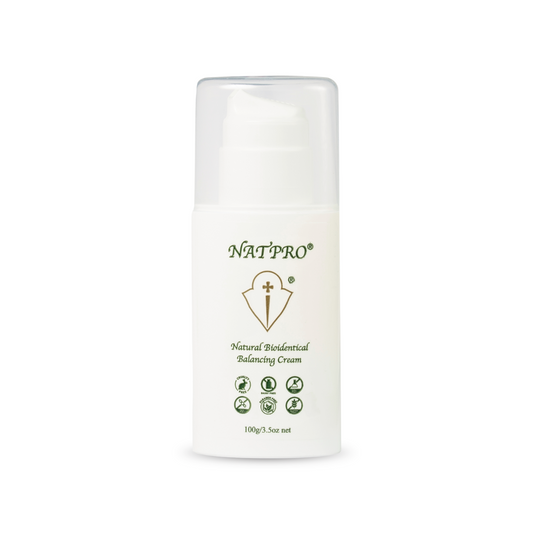
Natpro
Crema de progesterona bioidéntica totalmente natural
Productos destacados
-
Dispensador Natpro
Precio habitual $42.90 USDPrecio habitual -
 Agotado
AgotadoTubo Natpro
Precio habitual $25.70 USDPrecio habitual
Datos sobre Natpro.
Sin gluten ni lácteos
No se utilizan gluten ni productos lácteos en nuestra fórmula.
Libre de PEG
PEG significa polietilenglicol. Se encuentra en muchas fórmulas y ha generado preocupación últimamente por su potencial riesgo para la salud.
Sin parabenos
Utilizamos extracto de corteza de álamo temblón como conservante orgánico natural. Es un sustituto eficaz de los conservantes químicos habituales, como los parabenos.
Sin soja
La progesterona USP contenida en Natpro se deriva del ñame silvestre mexicano.
No confunda la crema de progesterona Natpro con una crema de extracto de ñame silvestre. Estas cremas no contienen progesterona.
Libre de OGM
No utilizamos ningún ingrediente modificado genéticamente en nuestra fórmula Natpro.
Libre de crueldad
Ningún animal ha sufrido ni sufrirá jamás a causa de la producción de Natpro.

Modo de empleo: Dispensador Natpro
1 dosis del dosificador le proporciona 50 mg de progesterona
Dosis diaria básica recomendada entre:
100 mg = 2 dosis
y
200 mg = 4 dosis
•Utilice la mitad de la dosis por la mañana y la otra mitad por la noche•
El uso de la dosis habitualmente recomendada de 20 a 40 mg/día solo agravará los síntomas de predominio de estrógeno.
Use entre 100 y 200 mg inicialmente para lograr el equilibrio y luego ajuste a una dosis que funcione para su cuerpo.
Para síntomas más graves, aumente la dosis a 400-600 mg hasta que los síntomas remitan. Reduzca la dosis gradualmente una vez que los síntomas graves hayan remitido.

Modo de empleo: Tubo Natpro
1 cucharadita (5 ml) de Natpro le proporciona 166 mg de progesterona.
Dosis diaria básica recomendada entre:
100 mg = 3 ml de crema Natpro
&
200 mg = 6 ml de crema Natpro
•Utilice la mitad de la dosis por la mañana y la otra mitad por la noche•
El uso de la dosis habitualmente recomendada de 20 a 40 mg/día solo agravará los síntomas de predominio de estrógeno.
Use entre 100 y 200 mg inicialmente para lograr el equilibrio y luego ajuste a una dosis que funcione para su cuerpo.
Para síntomas más graves, aumente la dosis a 400-600 mg hasta que los síntomas remitan. Reduzca la dosis gradualmente una vez que los síntomas graves hayan remitido.
Cómo utilizar Natpro para:
Fase prepuberal
Se administra a bebés prematuros, tanto varones como mujeres, con síndrome de dificultad respiratoria. Es eficaz para calmar y tratar cualquier dificultad para dormir en bebés y niños. Los bebés han sido bañados con este producto durante nueve meses antes de nacer.
La progesterona natural es la única hormona que no afecta negativamente a bebés o niños, ya sean varones o mujeres. Por lo tanto, si un adulto que la usa se expone a ella, no sufrirá daño alguno. A diferencia de la testosterona o el estrógeno, que causan efectos secundarios graves en bebés o niños, ya sean varones o mujeres.
Si se utiliza progesterona en un bebé o un niño, este es el único caso en que el tamaño importa.
Se puede aplicar a los bebés 1 mg de progesterona o una cantidad de crema del tamaño de una cabeza de alfiler.
Los niños mayores usan de 5 a 10 mg.
Sólo es necesario usarlo para ayudar al niño a superar una situación difícil.
Ayuda con los síntomas adversos experimentados antes de la pubertad y cualquier síntoma que se presente durante la pubertad.
Menarquia
La menstruación comienza aproximadamente dos años después de que comienza la pubertad y se conoce como menarquia.
Estos dos años pueden traer cambios de humor, rabietas, comportamiento desafiante, erupciones cutáneas y más. Los niveles de estrógeno y testosterona aumentan, pero no es hasta la menarquia y, con ella, la ovulación, que comienza la producción de progesterona.
Se debe utilizar 100-200 mg/día de progesterona, dependiendo de los síntomas.
Como no hay un ciclo a seguir, la progesterona se puede aplicar diariamente hasta que se inicie un ciclo.
Sangrado abundante/continuo
Es esencial utilizar una gran cantidad de progesterona si la menorragia o el sangrado excesivo y continuo es un problema.
Normalmente se necesitan entre 400 y 600 mg/día. Si el sangrado es continuo, úselo.
Tanto a diario como por hora. Usarlo cada hora mantiene el nivel alto durante todo el día.
Si tienes un ciclo menstrual, es mejor ignorarlo y usar progesterona a diario, incluso cada hora, hasta que el sangrado esté controlado. La progesterona puede usarse para regular el ciclo una vez que el sangrado se haya detenido.
Si el sangrado abundante ocurre durante la perimenopausia, la progesterona lo detendrá, pero no regulará nuevamente el ciclo.
A menudo se les recetan progestinas a las mujeres para detener el sangrado, pero éstas suprimen la producción de progesterona y tienen efectos secundarios adversos; consulte la página sobre anticonceptivos.
El aminoácido N-acetilcisteína es un potente antioxidante que puede ayudar a controlar el sangrado al inhibir las MMP. Considere tomar 2000 mg al día.
La vitamina D es esencial para el funcionamiento normal de todas las células y para prevenir la menstruación prematura. Realice un análisis de sangre para verificar sus niveles. Para más información, consulte GrassrootsHealth .
Tenga en cuenta que los especialistas en vitamina D recomiendan un mínimo de 50 ng/ml (125 nmol). El rango menos conservador es de 70-100 ng/ml (175-250 nmol/L), y no de 30 ng/ml (75 nmol/L), que se considera adecuado según diversos estudios.
Gobiernos. La dosis diaria mínima debería ser de 5000 UI al día. Aunque las últimas investigaciones sugieren 10 000 UI al día (véase aquí).
La taurina es otro potente antioxidante. Se han encontrado niveles bajos en mujeres con cáncer de endometrio, hiperplasia endometrial quística, fibromas y sangrado uterino disfuncional. Considere tomar 2000 mg al día.
Se ha descubierto que los bioflavonoides fortalecen los capilares. Estos parecen debilitarse en casos de sangrado o manchado abundante o continuo. La preparación utilizada en el estudio...
Compuesto por un 90 % de diosmina y un 10 % de hesperidina. Considere tomar 1000 mg/día.
Fase reproductiva
Esto dura desde la menarquia hasta la perimenopausia, cuando la fertilidad comienza a disminuir.
La duración normal de un ciclo menstrual varía de 21 a 35 días, siendo el promedio de 28 días. Por esta razón, los fabricantes de anticonceptivos y terapias de reemplazo hormonal (TRH) envasan sus productos en lotes de 28 días.
Los ciclos fuera de este rango generalmente se consideran anormales. Para más información, consulte las páginas sobre menstruación y síndrome de ovario poliquístico.
Todas las mujeres, independientemente de la duración de su ciclo, ovulan entre 12 y 14 días antes del sangrado.
Esta fase del ciclo se conoce como fase lútea o secretora.
La progesterona debe utilizarse durante la fase lútea, es decir, desde la ovulación hasta el sangrado, para complementar cualquier deficiencia.
La deficiencia puede deberse a una fase lútea defectuosa o a ciclos anovulatorios. Estos comienzan alrededor de los 35 años, momento en el que muchas mujeres experimentan un empeoramiento de los síntomas del síndrome premenstrual.
Se debe utilizar 100-200 mg/día de progesterona, o más si los síntomas son graves.
Duración normal del ciclo
Todos, incluso los profesionales médicos, dan por sentado que la duración normal del ciclo es siempre de 28 días en todas las mujeres. Esto simplemente no es así.
Varía entre 21 a 35 días, siendo 28 días el promedio solamente.
Existe un error fundamental al aconsejar a las mujeres que comiencen a usar progesterona el día 14. Esto sólo es apropiado para mujeres con un ciclo de 28 días.
Si una mujer tiene un ciclo de 21 días, comenzar el día 14 significaría que empieza a usar progesterona una semana después de la ovulación. Luego, solo usaría progesterona durante 7 días antes del inicio del sangrado.
De la misma manera, una mujer con un ciclo de 35 días comenzaría a tomar progesterona una semana antes de la ovulación,
Lo cual lo detendría eficazmente. Luego usaría progesterona durante 21 días.
La progesterona debe utilizarse siempre desde la ovulación, durante los últimos 12-14 días del ciclo.
O si se desea quedar embarazada, se puede iniciar durante el pico de 50 horas que ocurre antes de la ovulación.
La progesterona se puede utilizar mientras se está tomando un medicamento. Anticonceptivos. Debe usarse al tomar la segunda mitad del sobre.
La progesterona es segura de usar con cualquier medicamento, no hay contraindicaciones.
Perimenopausia
Esto suele comenzar de 5 a 10 años antes de la menopausia. A modo de orientación general, las mujeres suelen entrar en la menopausia aproximadamente a la misma edad que sus madres.
No hay cambios significativos al entrar en la perimenopausia, como el inicio del sangrado en la pubertad o su interrupción en la menopausia.
Muchas mujeres no presentan ningún síntoma, pero muchas sí, algunos bastante graves. Los niveles de progesterona están disminuyendo y siguen bajando a un ritmo cada vez más rápido. Esto se debe a la mayor frecuencia de ciclos anovulatorios.
Aproximadamente uno o dos años antes de la menopausia, los ciclos menstruales pueden volverse muy irregulares. Cada dos semanas o cada tres meses, es imposible predecir cuándo se producirá el sangrado. Este puede variar desde un manchado hasta una menstruación normal o un sangrado abundante.
Se debe utilizar 100-200 mg/día de progesterona, o más si los síntomas son graves.
Una vez que los ciclos se vuelven erráticos e imposibles de seguir, lo mejor es dejar de seguirlos y usar progesterona diariamente, incluso durante el sangrado. Es seguro hacerlo. Para más información, consulte Conceptos erróneos sobre la progesterona.
Irónicamente, no se da ninguna precaución a las mujeres que toman anticonceptivos continuamente, algunos de los cuales sólo contienen progestina.
Menopausia
Esto comienza, en promedio, a los 51 años. Es normal esperar un año antes de determinar que la menopausia ha comenzado. Muchas mujeres creen que sus problemas desaparecerán al llegar a la menopausia, pero a menudo no es así.
La ovulación ha cesado, la producción ovárica de progesterona y estrógeno se ha detenido. Sin embargo, las células grasas continúan secretando estrona, el estrógeno de la menopausia, hasta la muerte.
Desafortunadamente no hay secreción compensatoria de progesterona.
Muchas mujeres se hacen análisis de estrógeno y les dicen que están bajos. Pero lo que se analiza es el estradiol, el estrógeno premenopáusico, nunca la estrona, el estrógeno secretado a partir de la menopausia.
El estradiol debe ser bajo, varía de 0 a 30 pg/ml (0 a 110,13 pmol/L), consulte nuestra página sobre Pruebas hormonales para obtener más información.
Se debe utilizar 100-200 mg/día de progesterona, o más si los síntomas son graves.
Como no hay un ciclo a seguir, use progesterona diariamente. Muchas mujeres son
Se recomienda tomar un descanso, pero no es necesario. Para más información, consulte Conceptos erróneos sobre la progesterona .
Irónicamente no se da ninguna precaución a las mujeres que toman TRH continuamente.
Las mujeres que comienzan a usar progesterona por primera vez en la menopausia pueden tener un solo período, rara vez dos. Esto no es motivo de alarma.
Durante los meses o años siguientes, la pequeña cantidad de estrógeno secretada por las células grasas es suficiente para formar o engrosar el revestimiento. La progesterona limpia eficazmente el útero.
El sangrado ocurre con mayor frecuencia durante el primer año de la menopausia, pero se sabe que algunas mujeres, 12 años después de la menopausia, tienen un período cuando usan progesterona por primera vez.
Post-menopause
Post menopausal women have naturally low progesterone levels and are still subjected to the same endocrine disruptors as everyone else, further increasing estrogen levels and contributing to adverse symptoms.
100-200mg/day progesterone should be used daily.
Use half the dose in the morning and half in the evening to maintain levels.
If symptoms are severe increase the dose to between 400 - 500mg/day. You should expect to see results in 4 - 7 days on the high dose though sometimes it may take longer.
Once symptoms have eased the amount can be reduced. Whenever you reduce the dose, always do so slowly over a few weeks to negate symptoms flaring up again. As a guide reduce by 20mg per week. Reducing slowly allows your body to calibrate gently - giving you time to register the changes and how your body is responding to the current dose.
If you do not reduce slowly over a few weeks adverse symptoms may return. If they do you will need to increase the dose incrementally again by 20mg until you find the dose that stabilises symptoms.
If you have just started using progesterone it has been known for women 12 years into menopause to have a period when first using progesterone. This is nothing to be alarmed about. Over the course of the proceeding months or years the small amount of estrogen being secreted by fat cells is enough to build or thicken the uterine lining. The progesterone is effectively cleaning out the uterus.
If you are experiencing spotting and you are post menopausal seek medical care to rule out pathology.
If there is no pathological reason found, use between 100 - 200mg/day to help with the spotting.
Increase the dose to 400mg if needed and maintain this for 4-6 days before reducing the dose very slowly over the course of a few weeks until you find a dose that manages your symptoms effectively.
A progesterone cream can be used anywhere on the body, it does not have
to be applied to the thin skinned areas only. The skin comprises 95% kerotinocytes, these have ample progesterone receptor sites.
For more in-depth information visit our page Progesterone Therapy.
You are encouraged to refer any health problem to a health care practitioner and, in reference to any information contained in this web site, preferably one with specific
knowledge of progesterone therapy.
Hysterectomy
By removal of the uterus and possibly the ovaries, a woman goes into instant menopause. If the ovaries are not removed at the same time as the uterus, they will generally atrophy within two to three years.
In the recent past, following a hysterectomy, women were usually given HRT. However, with the publication of studies finalized in 2004, which proved beyond doubt that HRT can cause an increase in cancer (particularly breast cancer), stroke and heart disease, this practice has declined. Unfortunately few medical practitioners recommend progesterone regardless of the clear connection between progesterone and menopause.
100-200mg/day progesterone should be used daily.
Use half the dose in the morning and half in the evening to maintain levels.
If symptoms are severe increase the dose to between 400 - 500mg/day. You should expect to see results in 4 - 7 days on the high dose though sometimes it may take longer.
Once symptoms have eased the amount can be reduced. Whenever you reduce the dose, always do so slowly over a few weeks to negate symptoms flaring up again. As a guide reduce by 20mg per week. Reducing slowly allows your body to calibrate gently - giving you time to register the changes and how your body is responding to the current dose.
If you do not reduce slowly over a few weeks adverse symptoms may return. If they do you will need to increase the dose incrementally again by 20mg until you find the dose that stabilises symptoms.
As there is no cycle to follow, use progesterone daily. Many women are
advised to take a break, but it's not necessary. For more information see Progesterone misconceptions.
Ironically no caution is given to women who take HRT continually.
A progesterone cream can be used anywhere on the body, it does not have
to be applied to the thin skinned areas only. The skin comprises 95% kerotinocytes, these have ample progesterone receptor sites.
You are encouraged to refer any health problem to a health care practitioner and, in reference to any information contained in this web site, preferably one with specific
knowledge of progesterone therapy.
Hot Flashes
Under normal circumstances, women require 100-200mg/day progesterone, unless symptoms are severe.
Hot flushes, once started, only respond to levels of 400mg/day and over.
For severe hot flushes use 400 - 600mg progesterone per day. You should expect to see results in 4 - 7 days on the high dose though sometimes it may take longer.
Once symptoms have eased the amount can be reduced. Whenever you reduce the dose, always do so slowly over a few weeks to negate symptoms flaring up again. As a guide reduce by 20mg per week. Reducing slowly allows your body to calibrate gently - giving you time to register the changes and how your body is responding to the current dose.
If you do not reduce slowly over a few weeks adverse symptoms may return. If they do you will need to increase the dose incrementally again by 20mg until you find the dose that stabilises symptoms.
Men generally need 10-100mg/day progesterone, but 100mg/day and over will be needed to stop hot flushes.
A progesterone cream can be used anywhere on the body, it does not have
to be applied to the thin skinned areas only. The skin comprises 95% kerotinocytes, these have ample progesterone receptor sites.
For more informaiton see our page Cure for Hot Flushes
You are encouraged to refer any health problem to a health care practitioner and, in reference to any information contained in this web site, preferably one with specific
knowledge of progesterone therapy.
PCOS
A lack of vitamin D is found in PCO, with many authorities believing it could be the main contributing factor. A lack also leads to hyperparathyroidism which is often present in PCO. High levels of parathyroid hormone suppresses thyroid activity, leading to a higher than normal TSH level. The year round level of vitamin D should be 50ng/ml (125nmol/L) or higher.
Take a minimum of 5000 IU's Vitamin D per day, bringing the level in the blood to 50ng/ml (125nmol/L) or above.
Use between 150-250mg of progesterone per day
It should only be used at ovulation, for the last 14 days of the cycle, taking day 1 as the first day of bleeding.
Cycles can be very erratic or non-existent in PCO, if this is the case use a 28 day cycle to begin with, until the natural cycle exerts itself. This would mean using the cream from day 15 to 28. For more information please see this web page on how to use progesterone.
If symptoms are severe, please consider using the progesterone daily, through any bleeding that might occur. Do this for at least 3 months, before following the cycle once again. A scan will confirm if the cysts are being absorbed back into the body.
If after the 3 months the scan confirms the cysts are going, a cycle can be started using the progesterone following a 28 day cycle. This should prevent any further cysts developing and hopefully initiate ovulation.
If there is a cycle, but with spotting before a full period, between 200-250mg of progesterone will be needed during the last 14 days to prevent the spotting. The spotting is a sign that the progesterone level is dropping too low, too soon, to support the
endometrium.
Stress drops progesterone levels sharply so symptoms come back. Increase the amount used if stress should occur.
A progesterone cream can be used anywhere on the body, it does not have
to be applied to the thin skinned areas only. The skin comprises 95% kerotinocytes, these have ample progesterone receptor sites.
It's essential to take the necessary antioxidants, L-arginine and N-acetyl cysteine too. Take 500mg of each per day. Studies have shown these antioxidant amino acids restore gonadal function. Consult with your healthcare provider to establish
You are encouraged to refer any health problem to a health care practitioner and, in reference to any information contained in this web site, preferably one with specific
knowledge of progesterone therapy.
Breast cysts
The amount of progesterone will be dependent on the individual and the
severity of the problem.
Between 100-200mg/day of progesterone should be used.
In severe cases use 400 - 500mg/ day.
Use half the dose in the morning and half in the evening
Apply the progesterone cream directly to the breasts.
When dealing with breast cysts it's essential to keep dopamine levels up to inhibit prolactin production. Adding more protein to your diet will assist. Alternatively take 250mg/day tyrosine in the morning. This requires vitamin B3 and folic acid for conversion, so take 100mg B3 and 300mcg folic acid. Gradually increase the tyrosine dose until the optimum is found. It is safe to go up to 6000mg/day. There's no need to increase the B vitamins.
Excess oestrogen can also be reduced by Calcium D-glucarate. Oestrogen is metabolised in the liver by glucuronic acid, the process is known as 'glucuronidation'. The process also removes other substances, including toxins, drugs, bilirubin, androgens, mineralocorticoids and glucocorticoids.
It is then excreted in the bile, but an enzyme in the intestine called beta-glucuronidase breaks the oestrogen/glucuronide bond, which allows oestrogen to be reabsorbed. There's evidence beta-glucuronidase activity is increased in breast and prostate cancer. Calcium D-glucarate inhibits beta-glucuronidase. See here and here.
Another supplement worth taking is DIM(diindolylmethane). Oestrogen is broken down into two principle metabolites, 2-hydroxyestrone (2-OHE1) and 16-alpha hydroxyestrone (16alpha-OHE1).
16alpha-OHE1 is regarded as a potent oestrogen, whereas 2-OHE1 is a weak oestrogen. DIM increases levels of 2-OHE1, by doing so it also increases the ratio of 2-OHE1:16alpha-OHE1. This increased ratio is
associated with a lower risk for breast cancer.
Check for an iodine deficiency, and if found take chelated iodine or Lugol's Iodine. You can also rub the Lugol's Iodine directly onto the breast.
You are encouraged to refer any health problem to a health care practitioner and, in reference to any information contained in this web site, preferably one with specific
knowledge of progesterone therapy.
Ovarian Cysts
Ovarian cysts are abnormal sacs filled with liquid or semi-solid matter found in the ovary. They can vary in size from one or two centimetres to ten or more centimetres.
Almost all pre-menopausal women will have them at some time or another, but only about 15% of menopausal women experience them.
Cysts can occur as a result of excessive stimulation by follicle stimulating hormone (FSH), or luteinising hormone (LH), or a sensitivity to these gonadotrophins.
To address this imbalance progesterone is essential, so are vitamin D and other
antioxidants. The cyst/s are normally reabsorbed within three to six months, with continued use of progesterone and antioxidants they will not return.
Use between 100-200mg/day of progesterone, half the dose in the morning, half in the evening.
You can choose to use the progesterone with your cycle if you are still menstruating or you can use the progesterone daily and not follow your cycle to neutralise the imbalance and cysts more rapidly.
A progesterone cream can be used anywhere on the body, it does not have
to be applied to the thin skinned areas only. The skin comprises 95% kerotinocytes, these have ample progesterone receptor sites.
Vitamin D is essential for normal ovarian function, in particular ovulation. A lack is behind oxidative stress, PCOS and it reduces the benefits of progesterone. A test should be done to check blood levels and a minimum of 5000iu's per day should be taken. Consider taking 1600mg/day arginine and 1200mg/day cysteine. Both these amino acids are potent antioxidants.
For more information see our page on Ovarian Cysts.
You are encouraged to refer any health problem to a health care practitioner and, in reference to any information contained in this web site, preferably one with specific
knowledge of progesterone therapy.
Extremely stressful situations
Extreme cases of stress can be short lived or prolonged.
Using progesterone to help you manage stress requires personal and situation specific application.
If you are already using the basic recommended dose of 100-200mg/day of progesterone you will need to increase the dose up to 400 - 600mg/day during the stressful period. Once the cause of stress has passed reduce the amount slowly over a few weeks to your regular dose.
If you are coming to progesterone therapy for the first time to find relief from the effects of extreme stress start on 100 - 200mg/day and gradually increase the dose over a week to two weeks until you reach a dose that stabilises your symptoms. You may need to go up to 600mg/day. Maintain this dose until the stressful situation has neutralised, then gradually reduce the dose. If symptoms return increase the dose again.
Always split the dose up. Apply half the dose in the morning and half in the evening to maintain levels.
Alternatively you can choose to split the dose further and apply it four times a day or hourly depending of the severity of your situation.
Whenever you reduce the dose, always do so slowly over a few weeks to negate symptoms flaring up again. As a guide reduce by 20mg per week. Reducing slowly allows your body to calibrate gently - giving you time to register the changes and how your body is responding to the current dose.
If you are menstruating and going through an extremely stressful situation you can use the progesterone daily without following your cycle until the stressful period has subsided.This may disrupt your cycle but it will return to normal once you start using the progesterone with your cycle again (during the luteal phase).
A progesterone cream can be used anywhere on the body, it does not have
to be applied to the thin skinned areas only. The skin comprises 95% kerotinocytes, these have ample progesterone receptor sites.
You are encouraged to refer any health problem to a health care practitioner and, in reference to any information contained in this web site, preferably one with specific
knowledge of progesterone therapy.
Hombres
El uso de progesterona es fácil ya que no tiene un ciclo que seguir, por lo tanto, se puede aplicar diariamente.
Lo mejor es aplicarlo dos veces al día, con mayor frecuencia si los síntomas son graves.
Use entre 10 y 100 mg/día de progesterona, o más si se experimentan síntomas graves.
Se administran niveles superiores a 1200 mg/día a los hombres que han sufrido una lesión cerebral traumática .
Los hombres secretan <3,18 nmol/L (<1 ng/ml) de progesterona diariamente.
Please note...
-

No less than 3 months
Initially Natpro should be used for no less than three months to start feeling the benefits. Some bodies respond quicker and some take longer.
Using natural methods such as supplementing with bio-identical progesterone takes time and perseverance.
Much also depends on other influencing factors such as your environmental circumstances, diet, exercise, the personal and home care products you use and stress levels.
Many people give up before they have allowed the body enough time to adjust as we are so conditioned to expecting instant results.
Using enough bio-identical progesterone and using it correctly is essential to allow your body enough time to adjust. -

Estrogen dominance and environmental toxins
One of the functions of progesterone is to balance the estrogen in the body. If your system is being bombarded by excessive environmental estrogenic mimics, supplementing with progesterone can help alleviate the adverse symptoms associated with excess estrogen.
Be it from oestrogen mimics, normally called endocrine disrupting chemicals (EDC's), endogenous oestrogen or phytoestrogens from plants, the usually recommended 20 -40mg dose is not sufficient for this purpose initially as it only serves to stimulate estrogen.
Micronized progesterone regulation of the endometrial glandular cycling pool
Researchers are linking the rise in hormone related diseases to environmental toxins such as synthetic chemicals, especially pesticides which mimic the female hormone oestrogen. In particular these include DDT, dioxin and PCB's (polychlorinated biphenyls).
Implication of environmental estrogens on breast cancer treatment and progression
Endocrine disruptors: from Wingspread to environmental developmental biology
Endocrine-Disrupting Chemicals
State of the science of endocrine disrupting chemicals
Over 100 chemicals have now been identified as hormone disrupters, at least half of which resist the natural processes of decay, some persisting for decades, some for centuries. Approximately 2 billion tons of pesticides and countless billions of tonnes of industrial chemicals are used annually the world over.Visit the EWG database to check the ingredients of your personal care and household products.
-

Other factors
Progesterone will help if the problem is caused by a lack of it or if excess estrogen is present, but there are many other factors involved too, for instance a lack of vitamin D reduces the benefits of progesterone, please have a test done. The optimal range is between 70-100ng/mL. Nothing less than 5,000iu's is needed daily. Co-factors are needed when taking D3, magnesium and vitamin K2 are the important ones.
Large meals, dark gloomy days, winter, high adrenaline levels, excess blood glucose, a high amount of phytoestrogens in the diet, HRT and the contraceptive pill, all affect your levels adversely.
Stress drops progesterone levels drastically too, if you go through a very stressful period increase your progesterone dose to maintain levels. Practicing mindfulness techniques can contribute to managing stress levels.
Where possible eat a nutrient rich diet and stay away from processed foods and synthetic chemicals. Diet and nutrition are primary areas to focus on before choosing to supplement with anything. Eating foods that support your gut health is essential.
Be mindful of what household and personal care products you use. The EWG database is a good resource to check the chemical components of most products.
Support your journey to natural balance with any regular exercise your body is capable of performing and maintaining.You are encouraged to refer any health problem to a health care practitioner and, in reference to any information contained in this web site, preferably one with specific knowledge of progesterone therapy.
Contenido desplegable
Envío y garantía
Realizamos entregas a casi cualquier país desde nuestro centro logístico en Traverse City, Michigan, EE. UU.
Todos nuestros productos se envían en un plazo de 1 a 2 días laborables. Si un producto está agotado, le notificaremos antes de realizar su pedido. En ese caso (poco probable), le avisaremos en cuanto tengamos stock nuevo.
Garantizamos que nuestros productos son completamente nuevos y exactamente como se describen. No enviamos productos con defectos, de segunda mano ni de inferior calidad.
También garantizamos que su experiencia de compra será segura y placentera.
Embalaje
Si bien somos conscientes de que la composición química de los envases puede afectar el contenido del producto, estamos limitados a lo que hay disponible en el mercado actual. Inicialmente, usábamos envases de vidrio, pero esto resultó peligroso y derrochador, con tantas roturas.
Con esto en mente, hemos seleccionado y utilizado el plástico más seguro para el trabajo.
Visite la base de datos EWG para obtener datos de seguridad sobre el plástico PE que utilizamos para nuestros tubos.
Visite la base de datos EWG para obtener datos de seguridad sobre el plástico PP que utilizamos para nuestros dispensadores.
Por favor recicla.
Devoluciones
Respaldamos cada producto que vendemos. Si, por cualquier motivo, no está completamente satisfecho con su compra, con gusto la reemplazaremos una vez devuelto el original, siempre que recibamos su solicitud dentro de los 90 días posteriores a la fecha del pedido, sin costo alguno para usted. O bien, le reembolsaremos el precio total de la compra al recibir el artículo devuelto dentro de los 10 días posteriores a su solicitud.
Últimas publicaciones..
-

Control médico: progesterona natural vs. sintética
Realicé una investigación exhaustiva sobre ChatGPT en relación con los diversos usos terapéuticos de la progesterona. El informe resultante me llevó a cuestionar aún más por qué hay tan poca...
Control médico: progesterona natural vs. sintética
Realicé una investigación exhaustiva sobre ChatGPT en relación con los diversos usos terapéuticos de la progesterona. El informe resultante me llevó a cuestionar aún más por qué hay tan poca...






